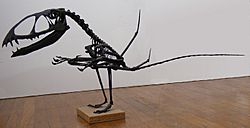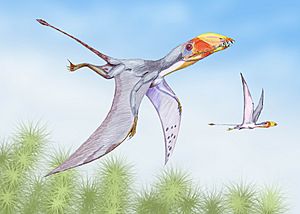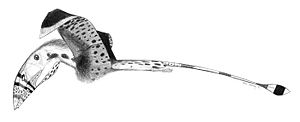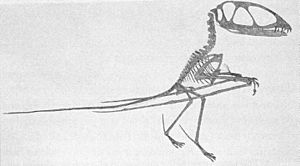Dimorphodon facts for kids
Quick facts for kids DimorphodonTemporal range: Lower Jurassic
|
|
|---|---|
 |
|
| Conservation status | |
|
Fossil
|
|
| Scientific classification | |
| Kingdom: | |
| Phylum: | |
| Class: | |
| Order: | |
| Suborder: | |
| Family: |
Dimorphodontidae
|
| Genus: |
Dimorphodon
Owen, 1859
|
| Species | |
|
|
Dimorphodon was a prehistoric flying pterosaur from the early Jurassic period. It had a big head, a small brain, a tall beak, and two types of teeth. Variation in teeth is rare in pterosaurs.
Like Rhamphorhynchus, Dimorphodon is only found in Jurassic strata. It was the first pterosaur found in England, by Mary Anning, in 1828.
Description
The body structure of Dimorphodon displays many "primitive" characteristics, such as, according to Owen, a very small brain-pan and proportionally short wings. The first phalanx in its flight finger is only slightly longer than its lower arm. The neck was short but strong and flexible and may have had a membraneous pouch on the underside. The vertebrae had pneumatic foramina, openings through which the air sacks could reach the hollow interior. Dimorphodon had an adult body length of 1 metre (3.3 ft) long, with a 1.45 metre (4.6 ft) wingspan. The tail of Dimorphodon was long and consisted of thirty vertebrae. The first five or six were short and flexible, but the remainder gradually increased in length and were stiffened by elongated vertebral processes. The terminal end of the tail may have borne a Rhamphorhynchus-like tail vane, although no impressions have yet been found in Dimorphodon fossils to confirm this speculation.
Skull
Dimorphodon had a large, bulky skull approximately 23 centimetres in length, whose weight was reduced by large openings separated from each other by thin bony partitions. Its structure, reminiscent of the supporting arches of a bridge, prompted Richard Owen to declare that, as far as achieving great strength from light-weight materials was concerned, no vertebra was more economically constructed; Owen saw the vertebrate skull as a combination of four vertebrae modified from the ideal type of the vertebra. The front of the upper jaw had four or five fang-like teeth followed by an indeterminate number of smaller teeth; the maxilla of all exemplars is damaged at the back. The lower jaw had five longer teeth and thirty to forty tiny, flattened pointed teeth, shaped like a lancet. Many depictions give it a speculative puffin-like 'beak' because of similarities between the two animals' skulls.
Palaeobiology
Diet
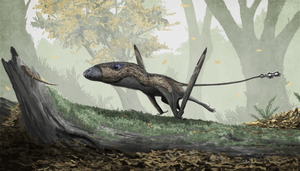
Our knowledge of how Dimorphodon lived is limited. It perhaps mainly inhabited coastal regions and might have had a very varied diet. Buckland suggested it ate insects. Later, it became common to depict it as a piscivore (fish eater), though Buckland's original idea is more well supported by biomechanical studies, and inconsistent with the animal's habits (see flight below). Dimorphodon had an advanced jaw musculature specialized for a "snap and hold" method of feeding. The jaw could close extremely quickly, but with relatively little force or tooth penetration. This, along with the short and high skull and longer, pointed front teeth suggest that Dimorphodon was an insectivore, though it may have occasionally eaten small vertebrates and carrion as well. Mark Witton has argued that the animal was a specialised carnivore, being too large for an insectivorous diet and therefore specialised to hunt small lizards, sphenodonts and mammals, though its relatively weak jaw musculature probably meant that it ate proportionally small prey.
Locomotion
Like many pterosaurs, Dimorphodon has been perceived as a soarer in the past, correlating to historical perceptions of pterosaurs as seabird analogues. However, more recent studies show that the animal was actually a rather poor flyer: its wings are proportionally short in relation to the body and its skeleton rather robust, offering very little gliding potential. In life, Dimorphodon probably relied on frantic short flights in the same manner as modern fowl, tinamous and woodpeckers, being unable to fly for long distances and probably only taking to the air as a last resort.
Interestingly, its derived position amidst primitive pterosaurs implies that this ineptitude is a developed trait, not an ancestral characteristic, as earlier pterosaurs like Preondactylus were capable aeronauts.
Owen saw Dimorphodon as a quadruped. He speculated that the fifth toe supported a membrane between the tail and the legs and that the animal was therefore very ungainly on the ground. However, his rival Harry Govier Seeley, propagating the view that pterosaurs were warm-blooded and active, argued that Dimorphodon was either an agile quadruped or even a running biped due to its relatively well developed hindlimbs and characteristics of its pelvis. This hypothesis was revived by Kevin Padian in 1983. However, fossilised track remains of other pterosaurs (ichnites) show a quadrupedal gait while on the ground and these traces are all attributed to derived pterosaurs with a short fifth toe. Dimorphodon's was elongated, clawless, and oriented to the side. David Unwin has therefore argued that even Dimorphodon was a quadruped, a view confirmed by computer modelling by Sarah Sangster.
Like most non-pterodactyloid pterosaurs, Dimorphodon was a competent climber, possessing proportionally large and curved ungals and a low center of gravity. Like modern squirrels, it probably moved in a saltatorial manner as it climbed.
Images for kids
-
D. macronyx holotype specimen, NHMUK PV R 1034
-
Reconstructed skeleton, Rainbow Forest Museum
See also
 In Spanish: Dimorphodon para niños
In Spanish: Dimorphodon para niños


